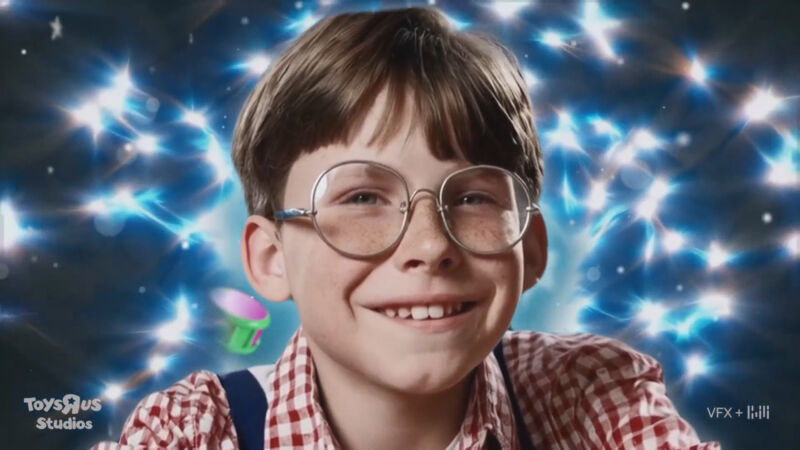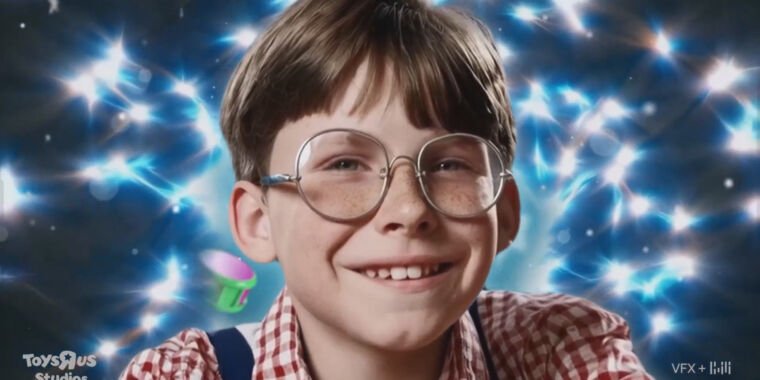
Toys R Us
On Monday, Toys “R” Us announced that it had partnered with an ad agency called Native Foreign to create what it calls “the first-ever brand film using OpenAI’s new text-to-video tool, Sora.” OpenAI debuted Sora in February, but the video synthesis tool has not yet become available to the public. The brand film tells the story of Toys “R” Us founder Charles Lazarus using AI-generated video clips.
“We are thrilled to partner with Native Foreign to push the boundaries of Sora, a groundbreaking new technology from OpenAI that’s gaining global attention,” wrote Toys “R” Us on its website. “Sora can create up to one-minute-long videos featuring realistic scenes and multiple characters, all generated from text instruction. Imagine the excitement of creating a young Charles Lazarus, the founder of Toys “R” Us, and envisioning his dreams for our iconic brand and beloved mascot Geoffrey the Giraffe in the early 1930s.”
The company says that The Origin of Toys “R” Us commercial was co-produced by Toys “R” Us Studios President Kim Miller Olko as executive producer and Native Foreign’s Nik Kleverov as director. “Charles Lazarus was a visionary ahead of his time, and we wanted to honor his legacy with a spot using the most cutting-edge technology available,” Miller Olko said in a statement.
In the video, we see a child version of Lazarus, presumably generated using Sora, falling asleep and having a dream that he is flying through a land of toys. Along the way, he meets Geoffery, the store’s mascot, who hands the child a small red car.
Many of the scenes retain obvious hallmarks of AI-generated imagery, such as unnatural movement, strange visual artifacts, and the irregular shape of eyeglasses. In February, a few Super Bowl commercials intentionally made fun of similar AI-generated video defects, which became famous online after fake AI-generated beer commercial and “Pepperoni Hug Spot” clips made using Runway’s Gen-2 model went viral in 2023.
-
A screen capture from the partially AI-generated Toys “R” Us brand film created using Sora.
Toys “R” Us -
A screen capture from the partially AI-generated Toys “R” Us brand film created using Sora.
Toys “R” Us -
A screen capture from the partially AI-generated Toys “R” Us brand film created using Sora.
Toys “R” Us -
A screen capture from the partially AI-generated Toys “R” Us brand film created using Sora.
Toys R Us -
A screen capture from the partially AI-generated Toys “R” Us brand film created using Sora.
Toys R Us -
A screen capture from the partially AI-generated Toys “R” Us brand film created using Sora.
Toys “R” Us -
A screen capture from the partially AI-generated Toys “R” Us brand film created using Sora.
Toys “R” Us -
A screen capture from the partially AI-generated Toys “R” Us brand film created using Sora.
Toys “R” Us -
A screen capture from the partially AI-generated Toys “R” Us brand film created using Sora.
Toys “R” Us -
A screen capture from the partially AI-generated Toys “R” Us brand film created using Sora.
Toys “R” Us -
A screen capture from the partially AI-generated Toys “R” Us brand film created using Sora.
Toys “R” Us
AI-generated artwork receives frequent criticism online due to the use of human-created artwork to train AI models that create the works, the perception that AI synthesis tools will replace (or are currently replacing) human creative jobs, and the potential environmental impact of AI models, which are seen as energy-wasteful by some critics. Also, some people just think the output quality looks bad.
On the social network X, comedy writer Mike Drucker wrapped up several of these criticisms into one post, writing, “Love this commercial is like, ‘Toys R Us started with the dream of a little boy who wanted to share his imagination with the world. And to show how, we fired our artists and dried Lake Superior using a server farm to generate what that would look like in Stephen King’s nightmares.'”
Other critical comments were more frank. Filmmaker Joe Russo posted: “TOYS ‘R US released an AI commercial and it fucking sucks.”

